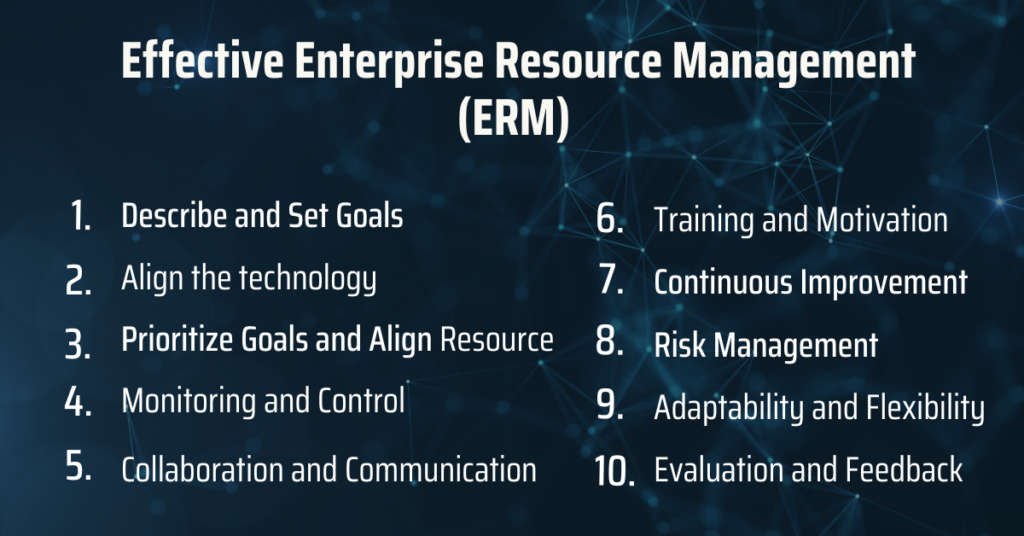
Enterprise Resource Management (ERM) involves planning, controlling, monitoring and optimizing the use of resources across an organization. Here is a list of high level pointers to manage enterprise resources effectively.
When we talk about resource management, we need to define and understand what the resources are from a business organization perspective. It may vary from business to business but broadly they are, 4Ms
-Man
-Material
-Machine
-Money
In a simplistic manner, meaning of management is how to make best use of these resources.
Now that you have the technology, identify, categorize, and define the resources properly in the software. Define what is the potential of each of these resources and limitations. Set goals for each of the resources in terms of quantity and value. Set goals for each manpower, each machine, each material, and every unit of money, what they are expected to do for the organization, and when they are supposed to do it.
Ensure that your ERP system knows these goals. Configure it in detail for every aspect of the above-mentioned 4M.
Download the business guidelines to the ERP software for it to help you in planning and monitoring.
Set the method of data collection and monitoring.
Set up broader goals for the organization, and align every resource to work for these goals. If there are constraints realign all 4M to do their best in a given situation.
Assign resources according to the critical needs and practically realign the priorities.
Optimize resource utilization: Ensure resources are utilized effectively and efficiently across different areas of the organization.
Configure your ERP process and workflow to accurately and optimally collect data required for monitoring. Keep track of how resources are being utilized and identify areas of improvement.
Implement automation to manage and regulate resource usage, ensuring adherence to budgets and schedules.
Ensure different teams communicate and coordinate effectively to optimize resource sharing and allocation.
Encourage open communication about resource needs and availability, implement agility in re-deployment
An organization is as good as its people. First M, Man is the key driver which would manage the other 3 resources. Train and motivate people to manage all the resources the way you would do. Foster a culture of resource consciousness and responsibility within the organization.
Continuously find ways to improve resource allocation and utilization. Use data-driven analytics to identify patterns, trends, and areas for improvement in resource management. Ensure that your ERP has a built-in analytics capability, it would be helpful in this.
Anticipate and mitigate risks related to resource scarcity, overutilization, or any other factors that might impact operations.
Have backup plans to address resource-related emergencies or unexpected changes.
The harsh reality of business is that it does not happen the way we plan, an effective plan is the one that is continuously realigned to meet the challenge reality poses. Enterprise resource management should be flexible enough to accommodate changes in technology, market conditions, organizational needs, or any other such conditions.
Regularly evaluate the effectiveness of resource management strategies and gather feedback from all stakeholders. Based on feedback, make adjustments and improvements to the resource management strategy.
ERM includes planning, controlling, monitoring, and optimizing the use of resources (Man, Material, Machine, Money) across an organization for efficient operation.
Technology, especially ERP systems, provides end-to-end visibility of resources. It helps in identifying, categorizing, and setting goals for each resource, ensuring optimal utilization.
Effective collaboration ensures resource sharing and allocation among different teams. Open communication about resource needs and availability enhances agility in resource redeployment.
Continuous improvement involves identifying patterns and trends using data-driven analytics. It ensures ongoing enhancements in resource allocation and utilization for better efficiency.
Business realities change, and effective resource management should be flexible to accommodate shifts in technology, market conditions, and organizational needs. Adaptability is key to success.